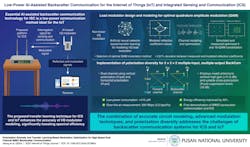Backscatter Method May Enhance Low-Power IoT Comms
What you'll learn:
- How a low-power backscatter methodology serves IoT devices.
- How the technology was developed.
- Benefits of the solution.
Addressing wireless communication between IoT devices, researchers from Pusan National University developed a low-power backscatter communication system to replace legacy approaches. The solution leverages circuit modeling, advanced modulation techniques, and polarization diversity to deliver a spectral efficiency of 2.0 bps/Hz and an improved energy efficiency that's 40% greater than legacy techniques.
The connected devices reflect and modulate existing signals by altering their load impedance, rather than generating signals themselves, using higher-order modulation schemes such as quadrature amplitude modulation (QAM) to achieve low bit error rates and high data rates. Although based on accurately modeled reflection coefficients, discrepancies between simulations and real-world measurements make it challenging to accurately predict the optimal reflection coefficient.
A research team led by Professor Sangkil Kim from the Department of Electronics Engineering at Pusan National University used transfer learning to accurately model the in-phase/quadrature or I/Q load modulators, introducing polarization diversity via multiple antennas for simultaneous signal transmission and reception.
By applying a transfer-learning approach, the researchers pretrained an artificial neural network (ANN) with simulated input bias voltages to familiarize the ANN with the load modulator behaviors across varying voltage conditions. This knowledge was then employed to train the ANN using experimental data to predict reflection coefficients based on VI and VQ inputs.
This transfer of knowledge improved predictions, achieving a minimal deviation of only 0.81% between modeled and measured reflection coefficient. This enabled the researchers to select optimal 4- and 16-QAM schemes, aligning predicted reflection coefficients with specific points in the QAM constellation to ensure energy-efficient data transmission, with total consumption below 0.6 mW.
The researchers developed a 2×2×2 MIMO transceiver system featuring two transmit and two receive antennas with different polarizations to enhance signal reception, throughput, and efficiency. Using a dual-polarized Vivaldi antenna, the team achieved a gain exceeding 11.5 dBi and a cross-polarization suppression of 18 dB.
The researchers tested their algorithm and MIMO BackCom system in the 5.725- to 5.875-GHz C-band, offering a 150-MHz bandwidth with a spectral efficiency of 2.0 bps/Hz using 4-QAM modulation. Demonstrating effective bandwidth utilization, they also attained an error vector magnitude of 9.35%, indicating high reliability and efficiency.
Related links:
About the Author
Alix Paultre
Editor-at-Large, Microwaves & RF
Alix is Editor-at-Large for Microwaves & RF.
An Army veteran, Alix Paultre was a signals intelligence soldier on the East/West German border in the early ‘80s, and eventually wound up helping launch and run a publication on consumer electronics for the U.S. military stationed in Europe. Alix first began in this industry in 1998 at Electronic Products magazine, and since then has worked for a variety of publications, most recently as Editor-in-Chief of Power Systems Design.
Alix currently lives in Wiesbaden, Germany.




